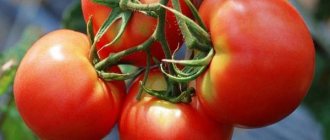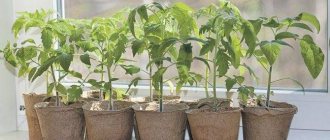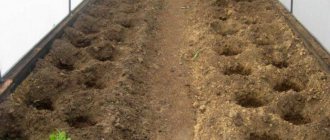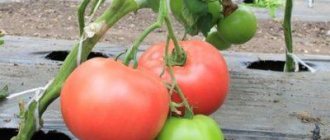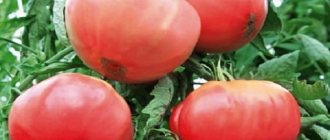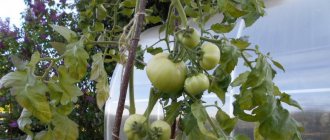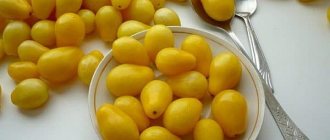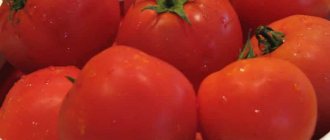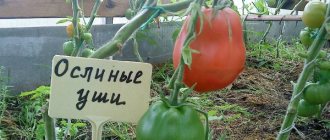Tomato Bells of Russia pleases with harvests even in unfavorable conditions and cool or hot summers. Advantages of the variety: productivity, excellent marketability and taste, endurance. The bushes, hung with abundant clusters of oblong colorful bell tomatoes, evoke the admiration of farmers.
| Height | Landing location | Ripening time | Fruit color | Fruit size | Origin | Fruit shape |
| short | Greenhouse, Open ground | Mid-early | Reds | Average | Variety | Pear-shaped |
Tomato Bells of Russia: variety description
Bells of Russia is a high-yielding mid-early variety.
Determinate bush, 50-60 cm high, standard. The formation of green mass is moderate, the leaves are small, light green. For better fruiting, a little pinching is required; heavy branches need to be tied up. The fruits are collected in beautiful clusters of 6-7 pieces. At the fruiting stage, the plant looks very decorative.
The fruits are oval, pear-shaped, very even. The weight of tomatoes is from 50 to 60 g . During the ripening process, the fruits change color from light green to rich pink-scarlet. The pulp is juicy, dense, low in seeds, with a high content of sugars and healthy amino acids. The taste is rich, sweet with a slight sourness. The glossy skin protects ripe tomatoes from cracking.
You can compare the weight of fruits with other varieties of tomatoes in the table below:
| Variety name | Fruit weight |
| Bells of Russia | 50-60 grams |
| Bobcat | 180-240 grams |
| Russian size | 650 grams |
| King of Kings | 300-1500 grams |
| Long Keeper | 125-250 grams |
| Grandma's gift | 180-220 grams |
| Brown sugar | 120-150 grams |
| Rocket | 50-60 grams |
| Altaic | 50-300 grams |
| Yusupovsky | 500-600 grams |
| De Barao | 70-90 grams |
Also read on our website: How to prepare soil in a greenhouse in spring? What types of soil for tomatoes are there? Which soil should be used for seedlings, and which is suitable for adult plants in greenhouses?
Agrotechnics of cultivation, planting and care
Sowing the seeds of this variety of tomatoes for seedlings is carried out 55-60 days before the intended planting in the ground. Picking seedlings at the stage of two true leaves. When planting seedlings in a permanent place per 1 sq. Up to 6 plants are placed per meter of plot. Watering and fertilizing are carried out as needed.
If you grew Kolokola Rossii tomatoes, please write whether you liked them or not. What was the yield and taste of the fruits like under your climatic conditions? How do you assess a variety's resistance to disease? Briefly describe the advantages and disadvantages of this tomato in your opinion. If possible, attach to the comment a photo of the entire bush as a whole or individual fruits that you grew. Thank you!
Your reviews of the Kolokola Rossii tomato and additions to the description will help many gardeners evaluate this variety objectively and decide whether it is worth planting or not.
Characteristics
A variety of Russian selection, intended for cultivation in open ground. In regions with short, cool summers, it is better to plant tomatoes in a greenhouse or greenhouse. Can be planted in flowerpots for home use. Productivity is good. From 1 sq. m of plantings, you can harvest up to 3 kg of tomatoes . The fruits are perfectly stored and can be transported without any problems.
You can see the yields of other varieties in the table below:
| Variety name | Productivity |
| Bells of Russia | up to 3 kg per sq.m |
| Lazy | 15 kg per square meter |
| Summer resident | 4 kg per bush |
| Doll | 8-9 kg per square meter |
| Fat Jack | 5-6 kg per bush |
| Andromeda | 12-20 kg per square meter |
| Honey Heart | 8.5 kg per square meter |
| Pink Lady | 25 kg per square meter |
| Lady Shady | 7.5 kg per square meter |
| Gulliver | 7 kg per square meter |
| Bella Rosa | 5-7 kg per square meter |
The fruits are ideal for whole-fruit canning; salted or pickled tomatoes look very beautiful and do not crack. It is also possible to use it fresh. Children like miniature pear-shaped tomatoes; they are also suitable for buffets or decorating dishes.
Among the main advantages of the variety:
- delicious fruits of unusual shape;
- tomatoes are suitable for canning and preparing various dishes;
- low maintenance requirements;
- calmly tolerates minor temperature fluctuations;
- resistance to major diseases.
Among the features of the variety are the demands on the nutritional value of the soil and the need for pinching the bush.
Productivity
Tsar Bell has an average ripening time, which is 100-110 days from the moment the seeds are sowed for seedlings. Usually, with the correct growing technique, gardeners begin to feast on sweet, aromatic fruits already in July.
This variety is characterized by a determinate type of bush, that is, the plant itself stops growing after the formation of all flower clusters. The plants grow short, compact, up to one meter high (in a greenhouse the bush can stretch up to 1.5 meters).
The large, strong stem is covered with 7-9 flower clusters with large, dark green, simple-shaped leaves. The first ovary is formed above the ninth leaf, the next ones - after 1-2 leaves. The fruits are formed 4 pieces per cluster.
Since the bush grows powerful and each cluster holds several heavy fruits, it is recommended to use supports and a garter (in some cases, each cluster is tied). For a better harvest, it is recommended to form the plant into two stems.
The main distinguishing feature of the variety is the giant heart-shaped fruits, which weigh 800 grams (the average is 400-600 grams). Tomatoes are characterized by a bright red color (sometimes with a crimson tint) with a dense, smooth skin and a fleshy interior. Tomatoes have both a sweetish tint and sourness, but in moderation.
Tsar Bell is a salad type of tomato. It goes well for slicing, as well as for preparing second courses. But these tomatoes exhibit their taste best when fresh. But for canning it is better to use other varieties.
The yield of the variety is average. Usually about 8-9 kilograms are collected from one square meter. However, with increasing doses of fertilizers, the yield can increase by 1.5-2 times.
Tomatoes ripen quickly after being picked and do not crack or get soggy. They do not lose their appearance during long-term transportation, and are also stored for a long time.
- large-fruited;
- fruits are stored for a long time;
- easy to care for;
- withstands temperature changes;
- tomatoes do not lose their excellent appearance during transportation;
- is immune to major diseases.
Features of cultivation
Seeds are sown for seedlings in the second half of March. When subsequently transplanting into a greenhouse, you can sow them earlier. The soil is preferably light, consisting of turf soil, humus and sand. The seeds are pre-soaked in a growth stimulator or freshly squeezed aloe juice, and then sown at a depth of 2 cm. The top of the container is covered with film and placed in a warm place. After the sprouts appear, the container is exposed to bright light.
In the phase of appearance of 2-3 true leaves, the seedlings are picked and fed with a complete complex fertilizer . Watering is moderate, only warm, settled water is used. Grown seedlings need to be hardened by taking them out into the open air, first for half an hour, and then leaving them outside for the whole day.
Planting in a greenhouse is possible in early May, in open ground - in late May-early June. Before planting, the soil is loosened and a small amount of complex fertilizers or wood ash is placed in the holes. The optimal planting scheme is 3 plants per 1 square. m. Thickening of plantings can cause diseases and reduce fruiting. Tomatoes like not too frequent, but abundant watering with warm water. Feeding is required with alternating mineral and organic fertilizers.
Of the minerals, preference is given to complexes with a high content of phosphorus and potassium; excess nitrogen causes the ovaries to shed. From organic matter, diluted mullein or bird droppings are suitable. Grown bushes are formed by removing part of the lateral shoots and lower leaves. It is better to tie branches with fruits to a support.
Plant care
Domestic gardeners grow a large number of varieties of tomatoes on their plots, differing in color, size, shape and even taste.
Of these, the “Apple Tree of Russia” variety clearly stands out, undemanding and fertile.
This tomato does not require special conditions; it produces high yields in all weather conditions and has a sweet, rich taste. Naturally, this vegetable quickly won the hearts of gardeners.
The “Apple Tree of Russia” tomato can be easily grown both in open ground and in a greenhouse. Of course, this will please those gardeners who have too small a plot for separate buildings. If desired, such tomatoes can even be planted in the courtyard of a city house.
However, this does not affect the essence of the matter - reliable support will be needed in both cases.
The description of the variety suggests that the plantings will be strong and powerful with small green leaves reminiscent of potato leaves.
The flowers are collected in brushes, each of which can subsequently produce up to eight tomatoes. In general, fruits are formed throughout the warm period.
They are quite dense, medium in size, with thin skin and weighing up to 100 grams. The color is even red, without spots.
The “Yablonka Rossii” tomato is an early-ripening variety. From the emergence of seedlings to the ripening of the first fruits, an average of 100 days pass. The variety will bear fruit until autumn. The first inflorescences appear after the ninth leaf.
Sometimes, in order to increase the amount of harvest, the stem is reshaped into two or even three shoots. However, it is worth it, because the yield is very high.
If you plant correctly and do not forget about care, then in a season it is quite possible to get from eighty to a hundred tomatoes from one bush.
“Yablonka Rossii” is used both in fresh salads, seasoned with various types of oil, and in side dishes and soups.
Since tomatoes are very dense, the skin will not crack, which means that they are convenient to prepare for the winter.
This variety is especially loved by gardeners because it is completely unpretentious and quite resistant to many diseases. There is no need to frequently water the plantings, feed them in any special way, or pinch them - the plant feels great without all this.
“Apple Tree of Russia” pleases gardeners with a large number of its characteristics.
- Firstly, this is an incredible yield. From one bush you can harvest as many as one hundred tomatoes, which guarantees approximately 6.5 kilograms of tomatoes per square meter of beds.
- Secondly, excellent taste and smell and, as a result, the ability to be used for preparing a number of dishes. Neat, dense tomatoes with fleshy pulp can be harvested for the winter, heat-treated, squeezed into juice and, of course, consumed in their original form.
- Thirdly, it makes sense to grow such tomatoes for sale. They are very appetizing and, most importantly, look the same, can easily withstand transportation and do not require special storage conditions. In addition, this variety bears fruit for quite a long time, which means it can be sold on the market for several months.
- Fourthly, tomatoes, in general, require practically nothing: neither frequent watering nor complex care. You can simply visit the dacha on weekends and devote time to vegetables once a week. It’s not for nothing that the “Apple Tree of Russia” is unofficially called “the variety for the lazy.”
- Fifthly, this species is not susceptible to most diseases typical of nightshades.
In general, there are practically no shortcomings in Yablonka Rossii. The only thing that can be mentioned is that this variety can suffer from late blight or become a victim of insect attack.
But still, the likelihood of this is extremely low, and late blight can be prevented.
Tomatoes cannot be planted in places where tomatoes and potatoes were already growing - late blight of predecessors can remain in the ground and spread to “newcomers”.
Reviews from those who have already planted the “Apple Tree of Russia” advise planting it using seedlings. It is best to use your own seeds, from those collected in the previous harvest.
It would be a good idea to treat the seeds themselves with potassium permanganate.
As soon as the seeds are distributed into containers with soil, they are covered with polyethylene and put away in a warm place. It is important to prevent exposure to sunlight, so seedlings should not be placed on the windowsill, but below the radiator is the place to be. The temperature should be kept between 20 and 24 degrees Celsius.
Watering is carried out using a spray bottle, the frequency is determined by eye - as soon as dried soil is noticeable, you immediately need to irrigate the seedlings. It is important to remember that tomatoes need to be exposed to light for 10 hours.
If the weather is bad, or the planting is initially planned in non-sunny regions, you should think about artificial lighting.
As soon as several leaves appear on the stems, the seedlings need to be picked, that is, planted in separate pots. This will help the root system develop well. Transplantation is carried out in well-moistened soil, very carefully so as not to harm the still undeveloped plant. Two months after germination, the plants can be sent to the garden.
A couple of weeks before planting in open ground or a greenhouse, tomatoes can begin to harden. To do this, they will have to be left for a few minutes near an open window, taken outside or into a greenhouse. Hardening off is important, as this procedure allows the plant to form a strong and stable stem.
If you decide to grow tomatoes outdoors, it is important to protect the plantings from strong wind gusts. This means that the beds are placed either near the fence, or against the walls of the house, or behind some tall crops, for example, sunflowers.
The seedlings are planted in pre-fertilized holes so that approximately 70 centimeters of free space remains between the bushes. Each seedling is buried, covered with soil, “slammed down” and irrigated with high quality water.
After about two weeks, it’s time to feed. There are several options for fertilizing tomatoes.
- First, you can sprinkle the soil with previously stored wood ash.
- Secondly, collect mullein, dilute it in a container with water and let it brew. You need to water carefully so that the fertilizer does not get on the stems and leaves of the “Apple tree”.
- Thirdly, it is recommended to feed the plantings with a herbal solution. Grass without seeds, such as nettle, dandelion and celandine, is placed in a large container. Everything is filled to the top with water.
When planted in the right place, the “Apple Tree” will not suffer from late blight and other typical diseases. However, there are a few exceptions to the rule. Tomatoes can be subject to bacteriosis, so much so that the bush withers overnight. The affected plant will have to be immediately removed from the garden and thrown away.
This can be prevented by timely treatment of seeds with potassium permanganate. In addition, tomatoes can develop macrosporiosis, which mainly affects the lower leaves. To prevent this from happening, it is important to promptly remove excess growth from the base of the stem.
Finally, the variety is susceptible to mosaic. Just as with bacteriosis, the plant will not be saved, but treatment with potassium permanganate will protect it from trouble.
If more serious methods are required, then tomatoes can be sprayed with any solution against the Colorado potato beetle. In addition, tomato bushes are often favored by insects such as whiteflies and aphids.
In both cases, the captured plant will need to be treated. Wormwood infusion, tobacco dust, or store-bought insecticides will help.
The collection of ripened tomatoes begins in the last month of summer and continues until the weather gets colder. Specific dates depend on the climate of the area.
You can also dig up the bush, transplant it into a bucket and then again put it in a warm place with sufficient lighting.
In general, fruits that have reached a certain size, red and green, are harvested.
To learn about the advantages of tomatoes of the “Yablonka Rossii” variety, see the following video.
The Bell of Russia tomato has gained popularity due to its taste, productivity and ease of care. It has many other advantages.
Characteristics and description of the variety Bells of Russia:
- Bell tomatoes of Russia can be found in the State Register of the Russian Federation for growing in open ground on personal plots. Tomatoes can also be planted in a greenhouse and grown on a loggia.
- This early-ripening and sweet variety is ideal for canning and pickling.
- The Russian Bells tomato is a determinate variety, that is, it has growth restrictions. The plant stretches up to 50 cm. The stems are erect. The medium-sized leaves are light green in color.
READ MORE: Grafting hazelnuts onto bear nuts, description of methods and timing
Reviews from vegetable growers about this tomato are positive. Those who planted the Bells of Russia variety note that the bushes take on a decorative form and can decorate any garden. This variety looks especially impressive when the fruits are ripening.
- precocity;
- endurance to adverse weather conditions;
- significant stable yields;
- versatility of use;
- cold resistance;
- heat tolerance;
- immunity to common pathogens;
- good germination;
- possibility of cultivation universally - in open and protected beds;
- excellent taste and product properties;
- excellent canning properties (fruits do not lose their shape and beautiful appearance, the skin does not crack).
Growing seedlings
- disinfection (use potassium permanganate);
- soaking in compositions with special growth stimulants;
- germination.
Growing seedlings
Pests and diseases: control and prevention measures
The variety is quite resistant to diseases. For prevention, you need to promptly remove weeds and mulch the soil with straw or peat. Spraying with a pink solution of potassium permanganate helps against gray rot; copper-containing preparations will prevent late blight. Frequent spraying with phytosporin also gives good results.
You can destroy insects using insecticides or proven folk recipes. Soapy water helps fight aphids; naked slugs and Colorado potato beetles are destroyed by an aqueous solution of ammonia.
See also what chemicals can be used to combat the Colorado potato beetle: Aktara, Corado, Regent, Commander, Prestige, Lightning, Tanrek, Apache, Taboo.
Bells of Russia is a promising variety for open ground, greenhouses or flowerpots. The plants are suitable for experienced or novice gardeners; they do not require excessive care, providing a stable harvest.
Useful video
Watch the video on how to properly feed tomatoes:
And in the table below you will find links to articles about tomatoes of various ripening periods that may be useful to you:
| Super early | Mid-season | Mid-early |
| White filling | Black Moor | Khlynovsky F1 |
| Moscow stars | Tsar Peter | One hundred poods |
| Room surprise | Alpatieva 905 a | Orange Giant |
| Aurora F1 | Favorite F1 | Sugar Giant |
| Severenok F1 | La La Fa F1 | Rosaliza F1 |
| Katyusha | Right size | Em Champion |
| Labrador | Dimensionless | Sultan F1 |
If you find an error, please select a piece of text and press Ctrl+Enter.

